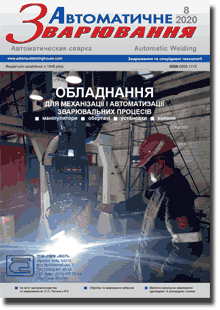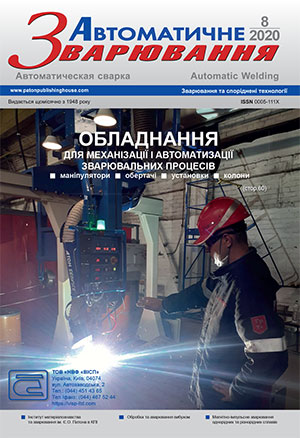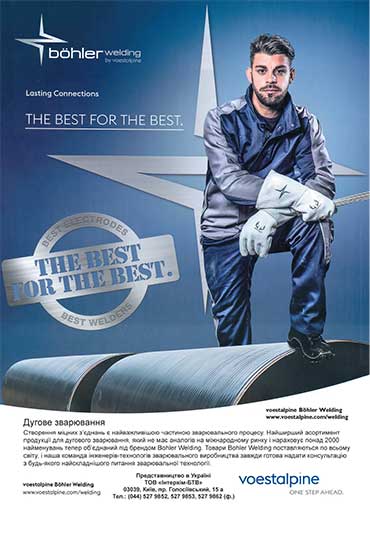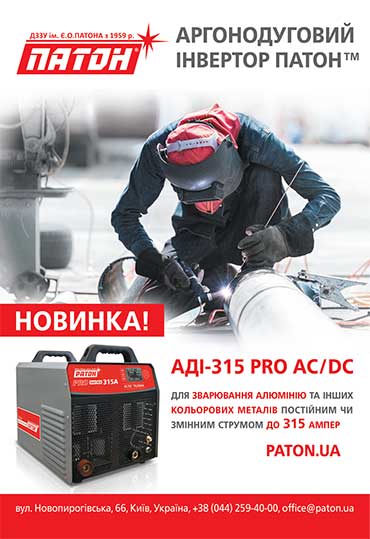| 2020 №08 (03) |
DOI of Article 10.37434/as2020.08.04 |
2020 №08 (05) |

"Avtomatychne Zvaryuvannya" (Automatic Welding), #8, 2020, pp. 27-31
Peculiarities of producing Al-Ti bimetal sheet joints by the method of vacuum diffusion welding
Iu.V. Falchenko, L.V. Petrushynets, Ye.V. Polovetskyi
E.O. Paton Electric Welding Institute of the NAS of Ukraine. 11 Kazymyr Malevych Str., 03150, Kyiv, Ukraine. E-mail: office@paton.kiev.ua
Given are the results of investigation of the effectiveness of application of vacuum diffusion welding technology to obtain aluminium-titanium bimetal sheets of 120×120 mm size. The effect of welding parameters on the joint microstructure and mechanical properties was studied. It is established that welding of foil materials is complicated, because of its low deformability. Application of thermally stable SiC and WC powders as «activators» in welding does not allow producing sound joints, because of hard particles embedding into the material being welded, and formation of defects in the form of throughthickness holes. It is shown that application of steel net for activation of plastic deformation on the foil contact surfaces, allows a significant lowering of welding pressure and producing defect-free joints between titanium and aluminium, with 1.7 times higher strength values, compared to layered Al+Ti joints, produced without using the net. 12 Ref., 1 Tabl., 6 Fig.
Keywords: aluminium, titanium, foil, bimetal joints, diffusion welding
Received: 07.07.2020
References
1. Petrushinets, L.V., Falchenko, Yu.V., Fedorchuk, V.E., Shinkarenko, V.S. (2018) Possibilities of manufacturing three-layer welded honeycomb panels from aluminium alloys. The Paton Welding J., 7, 25-29. https://doi.org/10.15407/tpwj2018.07.052. Bashurin, A.V., Mastikhin, E.Yu., Kolmykov, V.I. (2010) Diffusion welding of hollow bimetal panels. Zagotovit. Proizvodstva v Mashinostroenii, 1, 13-15 [in Russian].
3. Kim, J.S., Park, J., Lee, K.S. et al. (2016) Correlation between bonding strength and mechanical properties in Mg/Al twoply clad sheet. Metals and Materials Int., 22, 771-780. https://doi.org/10.1007/s12540-016-6217-0
4. Ma, M., Huo, P., Liu, W.C. et al. (2015) Microstructure and mechanical properties of Al/Ti/Al laminated composites prepared by roll bonding. Mater. Sci. & Engin.: A, 636, 301-310. https://doi.org/10.1016/j.msea.2015.03.086
5. Zhang, B., Kou, Y., Xia, Y.Y., Zhang, X. (2015) Modulation of strength and plasticity of multiscale Ni/Cu laminated composites. Materials & Design, 636, 216-220. https://doi.org/10.1016/j.msea.2015.03.075
6. Patselov, A., Greenberg, B., Gladkovskii et al. (2012) Layered metal-intermetallic composites in Ti-Al system: Strength under static and dynamic load. AASRI Procedia, 3, 107-112. https://doi.org/10.1016/j.aasri.2012.11.019
7. Hailiang, Yu, Cheng, Lu, A. Kiet Tieu et al. (2016) Annealing effect on microstructure and mechanical properties of Al/Ti/ Al laminate sheets. Mater. Sci. & Engin. A, 13, 195-204. https://doi.org/10.1016/j.msea.2016.02.087
8. Falchenko, Yu.V., Petrushynets, L.V., Polovetskii E.V. (2020) Peculiarities of producing layered metal composite materials on aluminium base. The Paton Welding J., 4, 9-18. https://doi.org/10.37434/tpwj2020.04.02
9. Lebedev, N.V., Agoltsov, A.Ya., Semochkin, A.N. (1980) Pressure welding of aluminium foil to copper one. Voprosy Atomnoj Nauki i Tekhniki, 1, 163-166 [in Russian].
10. Karpachev, D.G., Doronkin, E.D., Tsukerman, S.A. et al. (2001) Non-ferrous metals and alloys: Refer. Book. Nizhni Novgorod, Venta-2 [in Russian].
11. Kozakov, N.F. (1968) Vacuum diffusion welding. Moscow, Mashinostroenie [in Russian].
12. Grigorenko, G.M., Polovetsky, E.V., Falchenko, Yu.V. et al. (2012) Influence of preheating temperature on structure of bimetal joints of AMg6 in solid state with VT6 using VDW method. Sovrem. Elektrometall., 4, 37-41 [in Russian].




